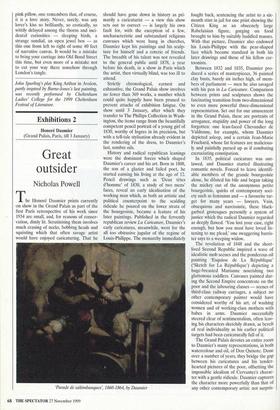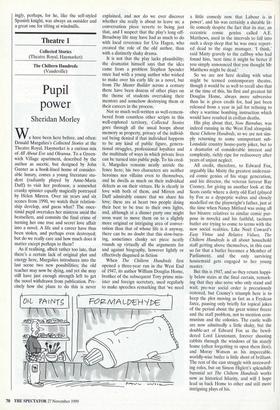Exhibitions 2
Honore Hauraki.
(Grand Palais, Paris, till 3 January)
Great outsider
Nicholas Powell
The Honore Daumier prints currently on show in the Grand Palais as part of the first Paris retrospective of his work since 1934 are small, and, for reasons of conser- vation, dimly lit. Scrutinising them involves much craning of necks, bobbing heads and squinting which that often savage artist would have enjoyed caricaturing. That he
should have gone down in history as pri- marily a caricaturist — a view this show sets out to correct — is largely his own fault for, with the exception of a few, uncharacteristic and substandard religious canvases which were hung in churches, Daumier kept his paintings and his sculp- ture for himself and a coterie of friends. The breadth of his talent was not revealed to the general public until 1878, a year before his death, in a show in Paris which the artist, then virtually blind, was too ill to attend.
Strictly chronological, earnest and exhaustive, the Grand Palais show involves no fewer than 369 works, a number which could quite happily have been pruned to prevent attacks of exhibition fatigue. On show until 3 January, after which they transfer to The Phillips Collection in Wash- ington, the items range from the beautifully competent pencil portrait of a young girl of 1830, worthy of Ingres in its precision, but with a tell-tale stylisation already evident in the rendering of the dress, to Daumier's last, sombre oils.
History and radical republican leanings were the dominant forces which shaped Daumier's career and his art. Born in 1808, the son of a glazier and failed poet, he started earning his living at the age of 12. Pencil drawings such as 'Deux tetes d'homme' of 1830, a study of two mens' faces, reveal an early idealisation of the working man which, as both an artistic and political counterpoint to the scalding ridicule he poured on the lower strata of the bourgeoisie, became a feature of his later paintings. Published in the fervently republican review La Caricature, Daumier's early caricatures, meanwhile, went for the all too obtrusive jugular of the regime of Louis-Philippe. The monarchy immediately 'Parade de saltimbanques', 1860-1864, by Daumier fought back, sentencing the artist to a six- month stint in jail for one print showing the Citizen King as an obscenely large Rabelaisian figure, gorging on food brought to him by suitably huddled masses. With that picture, Daumier also endowed his Louis-Philippe with the pear-shaped face which became standard in both his later drawings and those of his fellow car- toonists.
Between 1832 and 1835, Daumier pro- duced a series of masterpieces, 36 painted clay busts, barely six inches high, of mem- bers of parliament — men he also savaged with his pen in La Caricature. Comparison between prints and sculptures shows the fascinating transition from two-dimensional to even more 'powerful three-dimensional representation. Set out for our amusement in the Grand Palais, these are portraits of arrogance, stupidity and power of the long forgotten: one lean-faced Chevandier de Valdrome, for example, whom Daumier depicted asleep, and a certain Jean-Marie Fruchard, whose fat features are malicious- ly and painfully pursed up as if combating excruciating constipation.
In 1835, political caricature was out- lawed, and Daumier started illustrating romantic novels. Forced to leave identifi- able members of the grande bourgeoisie alone, he diluted his bile and began taking the mickey out of the anonymous petite bourgeoisie, quirks of contemporary soci- ety such as feminism and — a favourite tar- get for many years — lawyers. Vain, obsequious and narcissistic, these black- garbed grotesques personify a system of justice which the radical Daumier regarded as deeply flawed. 'You lost your case, right enough, but how you must have loved lis- tening to me plead,' one swaggering barris- ter says to a weeping widow.
The revolution of 1848 and the short- lived Second Republic inspired a wave of idealistic mob scenes and the ponderous oil painting 'Esquisse de La Republique' ('Sketch for La Republique') depicting a huge-breasted Marianne nourishing two gluttonous toddlers. Canvases painted dur- ing the Second Empire concentrate on the poor and the labouring classes — scenes of third-class railway carriages, a subject no other contemporary painter would have considered worthy of his art, of washing women and of working-class mothers with babes in arms. Daumier successfully steered clear of sentimentalism, often leav- ing his characters sketchily drawn, as bereft of real individuality as his earlier political targets had been caricaturally full of it.
The Grand Palais devotes an entire room to Daumier's many representations, in both watercolour and oil, of Don Quixote. Done over a number of years, they bridge the gap between his caricatures and his tender- hearted pictures of the poor, offsetting the impossible idealism of Cervantes's charac- ter with a gentle ridicule. Daumier captures the character more powerfully than that of any other contemporary artist: not surpris- ingly, perhaps, for he, like the self-styled Spanish knight, was always an outsider and a great one for tilting at windmills.



























































































 Previous page
Previous page